Mike Jastrzebski's Blog, page 54
October 18, 2012
Noodling away in Trinidad
by Christine Kling
One of the problems many cruisers face is the difficulty of staying fit. Cruising can be a rather sedentary lifestyle. In fact, sailing a cruising boat requires only rare short bursts of physical energy and these are not nearly enough to counteract the effect of the calories in the amount of rum consumed. So finding some sort of physical exercise is important if you want to continue to be able to crawl out of your dinghy.
I was first introduced to “noodling” (aka aqua aerobics) when I joined my friends Mark and Willie on their yacht Liahona in the Virgin Islands last November after completing the Caribbean 1500. They motored over to Peter Island, dropped the hook. Soon after, Willie handed me a noodle and told me to follow her into the water The main thing I remember from those first session in the anchorage was trying to beat the noodle into submission without drowning in the process.
Warning: if you think that reference to beating my noodle was an unintended pun, you’ve got the wrong impression of me.
 Anyway, no, I am not talking the sort of pasta that you eat. I’m talking about that glorious invention of modern man the pool noodle, aka woggles (UK), frites (France), or churros (Spain) – after all cruisers are an international community. These are the long colorful styrofoam tubes that either give one bad dreams from an old 90’s movie called Tremors, or the things that yachties are likely to slice up to use as insulation when they don’t feel like doing aqua aerobics any longer.
Anyway, no, I am not talking the sort of pasta that you eat. I’m talking about that glorious invention of modern man the pool noodle, aka woggles (UK), frites (France), or churros (Spain) – after all cruisers are an international community. These are the long colorful styrofoam tubes that either give one bad dreams from an old 90’s movie called Tremors, or the things that yachties are likely to slice up to use as insulation when they don’t feel like doing aqua aerobics any longer.
So, shortly after my arrival here in Trinidad, I was reunited with Willie Haskins of S/V Liahona and she recruited me to join the ladies in the pool for the class she leads in water aerobics. Aside from the fact that it is fun meeting new people and chatting in the pool every morning (okay, gossiping), the best thing about doing this exercise regime for over two weeks now is the fact that my shorts are getting baggier. I can tell the difference in my body already. And I’ve learned that in addition to knowing what to call a noodle, there are different kinds of noodles. The other morning, one of the ladies showed up with a Jumbo Noodle she had recently bought at Peakes. Of course, this prompted a serious discussion about girth and length and stiffness for the optimum noodle. Needless to say, one of the healthiest side effects of aqua aerobics is the laughter.
And I got many a chuckle out of the minor skirmish that took place shortly after my arrival that has come to be known in the annals of Trinidad history as “The Noodle Wars.” You see Willie’s aqua aerobics classes are very popular and the pool here in the marina where Wild Matilda and Liahona are docked is a very small pool. As the numbers of noodlers grew, one cruiser who was docked at a different marina invited the group over to their much larger pool. This other marina is also a bit more posh, i.e. expensive. The whole gang showed up for about three days in the fancy pool, but we eventually got kicked out in a very un-cruiser-like display of territorial defense. The great irony was that the person who complained that hordes of the great unwashed were daring to noodle their way into paradise later decided she too wanted to noodle and began to fight for her right to noodle! The intrepid noodlers refused to either pay for the right to noodle in the posh pool or be bought off – and the end result is there are winners and losers in the Noodle Wars. Next thing you know there will be a reality TV show on the Cruising Noodlers of Trinidad!
My friend Willie is actually a retired physical therapy professor from FIU, and she recently published a fabulous article complete with photos entitled “Staying Fit While Cruising with Water Aerobics” in the September issue of the magazine Caribbean Compass. You can download the entire issue at that link and you’ll find her article on page 24. I am trying to convince Willie that lots of cruising folk would like to follow her aqua aerobics exercises, most of which can be done in the ocean around your anchored boat with a simple styrofoam noodle. She really should put together an eBook and self-publish it, right? In the magazine article, they limited her to X number of photos, but in her book, she could include as many photos as she wants, and she could explain how to do the exercises just like she does for us in the swimming pool. Don’t you agree that it’s a great idea?
If you would like to see this book on water aerobics for cruisers, please help me convince Willie by leaving an encouraging comment here on the blog.
Fair winds!
Christine
p.s. My book Circle of Bones: a Caribbean Thriller will be free on Amazon from Friday 10/19 through Sunday 10/21. Please help me spread the word so I’ll give away thousands of copies!
Share on Facebook
Oh, hey. It’s Thursday…
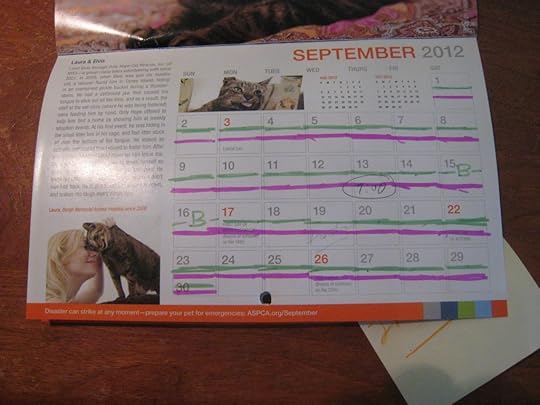
I know, it’s also October. But I have too many Post-its on that month, and September photographed better.
C.E. Grundler
That only occurred to me as I was updating my calendar for the day’s ‘Don’t break the chain’ entries.
If you’re not familiar with ‘Don’t break the chain’, it’s a wonderfully simply little motivational tool to keep you on track to reach a goal. It was made popular by a certain TV comedian I never watched, but recommended to me by a friend. It doesn’t matter what your goal, or goals, might be. A quick Google brings up plenty of links explaining it further, though I can sum it up here. All you do is get yourself a calendar that shows the month, or even the year, on a single page, and for each day you have completed the task that leads you to that goal, you make a simple mark. It might be an X, though I’ve found a single line works well, and lets me note a missed day, such as the 15th and 16th, where I was too exhausted after working on the boat to take the dogs (the green line) on their usual walk. The pink line is writing, and I don’t set a specific word or time limit. The brilliance behind this system is, once you’ve begun making your marks, you’re compelled to keep the chain going. Trust me on this. I’ve walked the dogs at midnight, in a downpour, rather than miss a day. And despite the drenching, they seemed to enjoy it all the same.
It goes without saying, there are plenty of aps for this, though my ASPCA calendar works fine for me. It’s kept me on track with my writing, as well as remembering to step away from the computer and give my canine companions (and my muses) some fresh air in their daily treks around town. And on occasion, it even helps to remind me what day of the week it is.
Share on Facebook
October 16, 2012
What I’ve learned from being a literary agent.
By Joyce Holland
First of all, like everyone else, I know how hard it is to try and land an agent, so the view from the other side was a revelation. I previously recall thinking that no one particularly likes or dislikes agents or editors, unless they have one. In the movies, agents lead an exciting life where they get to read all day and have relationships with their clients similar to the ones they have with their nearest and dearest. Sigh…I want to be one of those agents.
I suspect most writers believe agents who don’t love their writing haven’t really read it, they just say they did. Back when I spent months submitting queries and samples chapters I would have agreed with that analysis. Well, I do read them, but I admit I’ve reached burn-out. So, I’m taking a break and have closed to submissions until after the holidays. It was the trends that fried my brain. Trends that caused me to dream of wizard schools and blood dripping vampires arriving in flocks. Enough with the blood and magic. It became almost funny after a while. But, and this may amaze you, then came the family angst trend, which was by far the most painful for me. There are a million sad stories out there. The abundance of abused children and their pleas for help left me mentally wounded. I wanted to take them all in and heal them. Their ability to recover from their circumstances left me breathless. Or do they ever really recover? I don’t know, but after reading enough sad memoirs I have truly learned something, and here it is: The term ‘dysfunctional family’ is an oxymoron.
Of course, I learned a lot more from looking at over three thousand submissions. I found books I would have sworn I could sell, they were so beautifully done. Why was I the only one to see that? I’ve also seen books other agents sold, that made me wonder, am I in the wrong business. A group of friends was reading the Shades of Gray trilogy and said I had to as well, so we could discuss it. Even the sweet young girl who cleans my teeth was reading it. Huh? It must be good, she was halfway through book two. (I see her differently now)
Okay, I’m going to be honest here and tell you I would have turned that one down if it came across my desk. I said as much when I told the women my thoughts on the book. The weird thing is I found myself worrying they might judge me a prude. They did! Whoa, how did that happen? Come on folks, the plot was shallow and predictable. The graphic sex went on and on and on. And hey, nobody goes from being a virgin to nymphomaniac in one week. Talk about suspending disbelief, ha! So what sold that book? The forbidden element? Maybe. Enlighten me please, does today’s independent woman truly want to be adored, worshiped, and lightly abused if she misbehaves? Hell, I can buy the worshiped and adored, but–Jeez, guys.
All of which means I have learned something else from being an agent: Maybe I should stick to writing. Nah, I don’t mean that, but if I don’t find that jewel in the slush pile by next summer, I’m going to give it some serious thought.
Best,
Joyce, the slow learner.
Share on Facebook
October 15, 2012
The trouble with deadlines
By Mike Jastrzebski
I wrote in my last blog that we were planning to leave Cape Canaveral next month. I also listed the projects I hoped to complete before we leave. Well, it ain’t gonna happen. We made the decision this weekend that we are going to need another month to get things done.
Now I understand that at times you need to just go whether the projects are done or not. We did that this past spring which is one of the reasons we have so much left to do right now. The thing is, there are three major projects I feel still have to be done before we leave.
The first is the solar panels. We are driving down to Ft. Lauderdale Wednesday to pick up three 140 watt panels. I figure building the framework to support the panels, mounting them, and wiring the panels will take five or six days.
Next I have to repair and connect our third water tank. Since all of our tanks are small, and we plan on being gone at least six months, we need all the water storage we can get. I figure this will take another five days.
The final must do project is to install a hand bilge pump. Running the hose will be the biggest problem there. Again, maybe five days of work.
On top of this we still have to provision and sell the car, so the numbers just don’t add up for a November departure. The good thing about postponing our departure until the first week of December is that we’ll be able to attend the Seven Seas Cruising Association’s Melbourne Gam. The Gam is Dec. 7-9 and we have to pass right by Melbourne on our way south. If you happen to be there I hope you’ll stop by Rough Draft and say hi.
Share on Facebook
October 11, 2012
Migrations
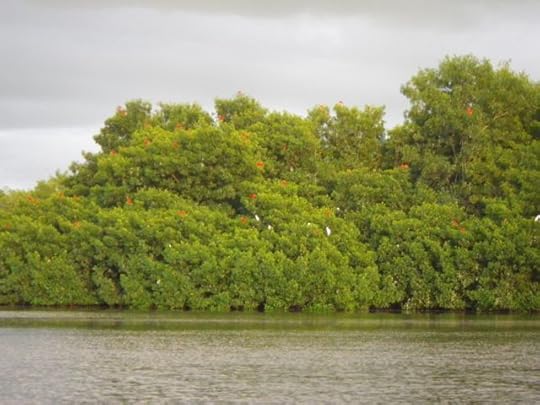
Scarlet ibis roosting in Caroni Swamp, Trinidad
by Christine Kling
Cruising sailors are migratory animals. Like birds, they migrate in response to weather, habitat or food availability.
I’ve been in Trinidad for about ten days now staying aboard Wild Matilda, and I can attest to the fact that the major reason most boats migrate here is due to weather. It is extremely rare for hurricanes to come this far south. Though there was that pesky hurricane of 1933 that crossed right over the island with 85 MPH winds, since then, it has mostly been rare brushes with tropical storm force winds. Most insurance companies totally buy into the idea that there are never any hurricanes that touch Trinidad.
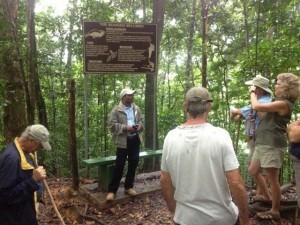
Tour guide at Asa Wright
In addition, cruisers come here for the wonderful habitat. Trinidad is one of the most prosperous and modern islands in the Caribbean, and there are marinas, shops and boat yards where cruisers can get boat supplies and find skilled workers to help them work down their boating to-do lists during the off-season. Many yachties spend from 3-6 months here in Trinidad. But even beyond the great boat repair spot, Trinidad has some beautiful natural habitat for cruisers to see.
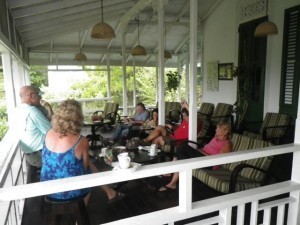
Cruisers on Asa Wright Lodge veranda
Over the last couple of days, I traveled with eight other sailors up into the rain forest to a bird sanctuary called the Asa Wright Nature Center. The Center is located on a former cocoa and coffee plantation and the main lodge is the former plantation house that was built in 1906. We spent the night up there, watched the birds from the terrace, hiked many trails through the rain forest both with guides and without. We saw several agoutis (a large rodent), a golden tegu (big lizard) and dozens of varieties of hummingbirds.
On the return trip today, we visited the Caroni Swamp and took a boat ride out to see the Trinidad national bird, the Scarlet ibis. We thought we would be lucky to see just one – and in the end we saw hundreds. In addition, along the way, we saw a tree boa, two caymans, a jumping four-eyed fish, and a variety of other birds.
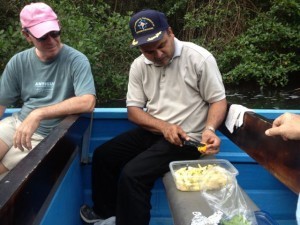 And finally, there is the issue of food availability. Nobody eats like the Trinis do. We took this trip around the Trinidad habitat with the Trini Cruising Community’s favorite guide, Jesse James of the Members Only Maxi Taxi fame. This man knows Trini food and loves to share it with guests to his island. He took us to try some street food from his favorite truck on the first day and we had doubles, saheena, kachori and enough hot sauce to set fire to our mouths. Later on the swamp tour, he made Pineapple Chow that included cut fresh pineapple, salt and peeper, chopped fresh peppers, and a cilantro-like local herb. The delicious, hot, spicy pineapple tasted little like the fruit I am familiar with.
And finally, there is the issue of food availability. Nobody eats like the Trinis do. We took this trip around the Trinidad habitat with the Trini Cruising Community’s favorite guide, Jesse James of the Members Only Maxi Taxi fame. This man knows Trini food and loves to share it with guests to his island. He took us to try some street food from his favorite truck on the first day and we had doubles, saheena, kachori and enough hot sauce to set fire to our mouths. Later on the swamp tour, he made Pineapple Chow that included cut fresh pineapple, salt and peeper, chopped fresh peppers, and a cilantro-like local herb. The delicious, hot, spicy pineapple tasted little like the fruit I am familiar with. 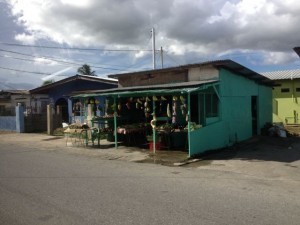 He stopped along the road in a predominantly Hindu village and bought a variety of homemade sweets that were to die for. Without Jesse as our guide, we might be left believing that the only food available in Tinidad was KFC.
He stopped along the road in a predominantly Hindu village and bought a variety of homemade sweets that were to die for. Without Jesse as our guide, we might be left believing that the only food available in Tinidad was KFC.
I learned recently that approximately 1800 of the world’s 10,000 bird species are long-distance migrants. The number of migrating cruisers in an even smaller group within the human species, but it is a group that welcomed this nomad into their flock – even if only for a few short weeks.
Fair winds!
Christine
Share on Facebook
How could anyone live that way?
C.E. Grundler
Work has been proceeding nicely aboard Annabel Lee, and the boat is truly starting to resemble a workable, livable boat, which makes it easier to stay aboard for days at a stretch, which, in turn, increases the hours of work accomplished each day. I sleep soundly through the night even while the boat rattles and shakes as freight trains rumble past. I wake well-rested, stroll across the lot to the head, then heat some tea in the hot pot and watch the sunrise over the river. Not a bad way to start the day. The only thing that would make it better would be some bacon and eggs. But I don’t have an operational galley at the moment, and that set me on an odd quest, one that left me considering the state of our society these days.
The solution to my dining dilemma seemed relatively straightforward. My cookware – a cast iron skillet and three ancient Farberware pots of varied sizes, were still aboard. I simply needed a single electric burner and I’d be good to go. And there was a Bed, Bath and Beyond on the highway just down the road. So on my way to the hardware store for more sandpaper, I ventured into this temple to all the modern home could ever want or need in the kitchen and bath. I wandered the aisles, overwhelmed by the assortment of gadgets I’d never imagined anyone could have a need for, even as other shoppers filled their carts. One sales clerk even offered to bring me a cart – clearly I wasn’t properly prepared for my shopping experience in this store. He asked if I needed help finding what I’d come for.
I described what I was seeking, and he led me to the area where aisles of electrified cooking apparatus of every shape and size awaited. Many bore the names of celebrity chefs I’d never heard of, all smiling at me from the boxes, all touting the specialized benefits of these devices. But no single electric burner, celebrity endorsed or otherwise. The sales clerk asked what I intended to prepare, and seemed taken aback when I replied, “Food.”
“What kind of food?” he pressed, then went on to explain how each of the products displayed could aid that process. Another shopper, while weighing the merits of one deep-fryer over another, assured me that the XYZ Griller made the best grilled cheese sandwiches imaginable… she’d be lost without hers. “What are you cooking?” she chimed in.
“Food,” I replied again. I know they were both trying to be helpful, but when I clarified what I needed and why, the responses I got were almost comical. One hotpot, one burner, four pieces of cookware…on a boat? How could anyone live that way?
I looked around the store, already festooned with aisles of holiday decorations that shoppers were eagerly snapping up. Not Halloween, not even Thanksgiving. No, the Christmas stuff was already out, and likely had been since September. I looked at the carts, brimming with merchandise our grandparents could never have imagined, and as I recall, lived quite well without. Over the years marketers have become more adept at convincing people they’ll be happier with newer, shinier, more. And society, as a whole, keeps buying what they’re selling.
Myself, I left Bed, Bath and Beyond empty handed. It turns out that the local hardware store had both the sandpaper and a portable single burner electric range. I stopped off at the grocery, then went back to the boat and made a grilled cheese sandwich for lunch. I sat back and reflected on how little I had, how well it works for me, and how perfectly happy I am with that.
Share on Facebook
October 9, 2012
Sailors & Baggywrinkles
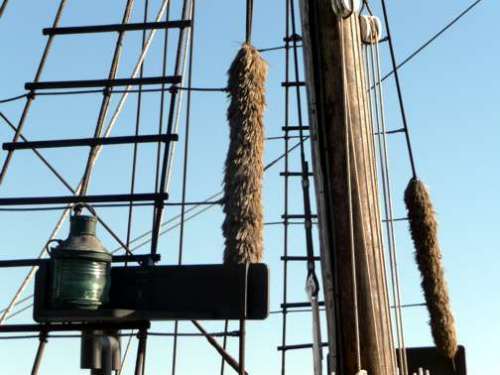
(Photo Courtesy of BoatSafe.com)
Earlier this summer, I was walking the docks in Newport when I came upon an old schooner that now works as a charter day-boat.
“Are those Baggywrinkles?” I asked, my eyes aimed up at the rigging.
“Yes, they are,” the deck hand replied, surely thinking I must be a schooner man out of Glouchester (either that or one more dockside boat geek). “How’d you know about Baggywrinkles?”
“My morther-in-law.”
Pause. (Okay, this week I’ll find out for sure if she really does read this blog.)
Actually, my mother-in-law is a smart, lovely woman who knows a fair amount about the sea. In this case, her knowledge is informed by her sister who was a part owner in the famed Glouchester fishing schooner Adventure when it sailed as a windjammer out of Maine, back in the 50’s.
It’s an odd name, but old salts and schooner hands know that Baggywrinkles are the soft, fuzzy looking padding made from frayed rope that is found on the shrouds of old sailing boats, their purpose being to limit wear and chafing on the sail. In a harsh wind, they cushion the sails from slapping against the rigging, thus reducing the friction that would wear at the canvas.
You can still find Baggywrinkles on sailboats, but the term may also be working its way into popular culture.
Before you know it we might all be talking about Baggywrinkles. They might start turning-up on on reality shows, TV ads, in songs. You think I’m kidding? Heck, a local micro brewery out on Nantucket has even gotten into the act with their own Baggywrinkle brew.

A little web research even showed that the term is showing up across the Atlantic.
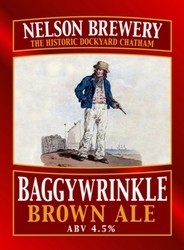
So keep an eye out for Baggywrinkles. When this all goes mainstream the readers at Write-On-The-Water will be ahead of the learning curve. And when you start noticing your own Baggywrinkles I hope you’ll remember to thank me for calling them to your attention.
Share on Facebook
October 8, 2012
Shamus Award Nominee
My short story, “Vampire Slayer Murdered in Key West,” did not win the Shamus award this past weekend. I was disappointed, but the fact that I didn’t expect to be nominated, not even thought of being nominated, makes being nominated a prize in itself.
I worked on the Academy Award for years in Los Angeles and heard that comment – being nominated is an award in itself – from people and thought it was BS. When I received the email from Janet Hutchings, editor of Ellery Queen Mystery Magazine, that the story had been nominated, I was surprised, to say the least.
I also realized that being nominated for an award by your colleagues is an award of recognition. More so, in my case, since I never considered that my story would be in the running. But it is a great feeling to realize that my fellow writers thought the story was written well enough to nominate it.
I am not aware of who the nominating committee was, but they have my undying thanks. Their decision to include me on the short list for the Shamus made me realize that my hours at the computer have not been a waste of time and that I have, no matter what some critics say, a recognizable talent.
I will have a collection of my short stories available on Kindle and as a trade paperback on Amazon within a few weeks. Included will be “Vampire Slayer Murdered in Key West.” Each of the stories in the short volume has a brief introduction about how the story came about. I hope, if you are interested, you will check it out.
Here is a list of the Shamus winners. I send my congratulations to one and all, espically Michael Z Lewin.
The Private Eye Writers Association presented the Shamus Awards last Saturday night.
Best Hardcover P.I. Novel:
A Bad Night’s Sleep, by Michael Wiley (Minotaur)
Best First P.I. Novel:
The Shortcut Man, by P.G. Sturges (Scribner)
Best Paperback Original P.I. Novel:
Fun & Games, by Duane Swierczynski (Mulholland)
Best P.I. Short Story:
“Who I Am,” by Michael Z. Lewin (Ellery Queen Mystery Magazine, December 2011)
The Hammer–a commendation celebrating a memorable private-eye character or series, and named after Mickey Spillane’s Mike Hammer–was presented to Nate Heller the character created by Max Allan Collins.
Share on Facebook
October 7, 2012
29 days and counting
That’s November 6th, the day we hope to leave Cape Canaveral and head back south and over to the Bahamas. I’d like to say that I’m excited by the prospect, but that feeling will come later. Right now I’m just tired. Tired of the work, tired of the aching back, and tired of the stress of trying to cram too much work into too few hours.
This is not something new. I’ve felt this way every time we’ve prepared to take off on a trip. To give you an idea of what we’re up against, here’s an example of my to-do list for October.
Purchase and install three solar panels, empty our storage locker, get the washdown pump working, repair and connect our third water tank, install two more golf cart batteries, and lower our bimini so that the mainsail doesn’t rub when we tack. These are the things I feel must be done before we leave.
I would also like to add a water filter, build storage for our second and third anchor, and install the transducer that will allow our chartplotter to show depth. The transducer is last on the list because we already have a depth sounder on the boat, but it’s mounted across the cockpit from the steering wheel and with sunglasses on in the bright sunlight, it’s a bit of a chore to read the depth.
Now this is a small list compared to what we had when we arrived at Harbortown Marina, and it’s nice to feel as if the hard work will be coming to an end, but I’ve been boating long enough to know that the hard work never really ends.
We’ll travel for a little while, something will break down, then something else, and the list will begin to grow again.
So is it worth it? What do you think? I sure as hell look forwad to the coming months of island hopping, sailing in clear clean waters, and afternoon cocktails in the cockpit.
What about the rest of you sailors out there–what do you look forward to most when you’re prepping your boat for that next adventure?
Share on Facebook
October 5, 2012
Time warps
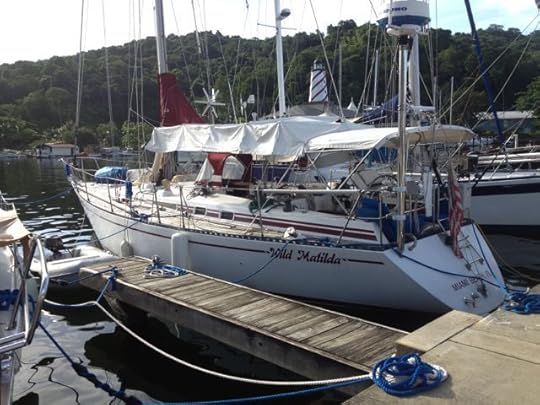
Wild Matilda at the dock in Coral Cove Marina, Chaguaramas, Trinidad
by Christine Kling
I struggle with time. As a general rule, you can count on me to be slow. I think that’s a big part of the reason I like sailing so much. There is no expectation of real speed. I like it that way. You see I am that person at the traffic signal who always waits for the light to turn green before I shift my car into gear, and far too often, the car behind me blasts his horn in the three seconds before I move forward.
Therefore, on Tuesday morning when my son dropped me off curbside at the Miami International Airport, I was not in my element. Hundreds of people were rushing around me with their wheeled bags. My only checked luggage was a 61-pound replacement headsail for my friend Bruce’s boat.
“Where are you headed?” the fellow at American Airlines asked.
“Trinidad.”
“Lucky you.”
“Yeah.” I smiled for the first time that morning.
This is my second trip to Trinidad. The first time I sailed down on board Sunrise with my husband and 10-year-old son. That was roughly 18-19 years ago. As soon as I write that line, I have the natural inclination to follow that with the cliché, “Time flies.” When I think back on that month that we spent med-moored to the wall at TTYC, the Trinidad and Tobago Yacht Club, the images are bright and clear in my memory. It doesn’t seem like nearly 20 years ago. Where have the years gone? I think many people will agree with me when I say that as I age, each year seems to speed by faster.
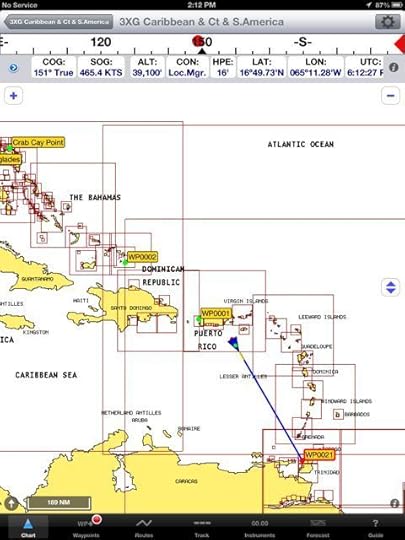
Notice the SOG (Speed over Ground) and the ALT (altitude)
So then why was it that when I finally boarded the plane, and the captain then announced we had technical problems and would be delayed – why, oh why did it seem like time suddenly slowed to a crawl? They asked us all to deplane and take our luggage with us and as the crowd grumbled and pulled their bags out of the overhead compartments, it seemed as though it took far longer to get off than it had to get on. And when we were called to re-board a couple of hours later, why did the flight seem to take forever even though our speed, as recorded on my iPad, was significantly better than what I make on my boat?
How is it that the years seem to speed past, but within that time there are so often moments in meetings or in traffic or while waiting for a delayed flight, that time slows to an excruciatingly slow pace?
I’ve been thinking a lot about time on this trip. How is it that the plane trip (after 4 cups of coffee) traveling at 464.5 knots can seem interminable while the sailing passage sometimes goes by too fast?
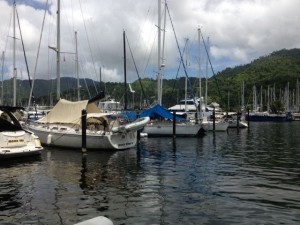
CrewsInn Marina
Trinidad has also changed significantly from 1994. There are lots more marinas and they are full of cruisers’ boats. The boats are mostly bigger and newer with gobs more fancy gear, and the majority of the folks look prosperous. But one of the biggest changes I’ve seen is how much more social the cruisers have become. Our time is scheduled down to the minute. At 8:00 a.m, the day begins with the Cruisers’ Net on channel 68, then it’s off to aqua-aerobics with Willie. After that we must shop for the Friday barbecue . There are days for shopping at the fruit and vegetable market, excursions to visit island sights, Sunday evening cocktails, and movie/sushi night. I can’t keep any of it straight and I’m finding it somewhat exhausting just worrying about where I should be when. I understand that at Georgetown in the Exumas and at places in Grenada, the cruisers have similar jam-packed social schedules, and it makes me wonder why it is that folks who have quit the “rat race” of schedules and appointments, seem to recreate some of that madness out here. Is it just human nature? Or are the people cruising today different than they were when I first started cruising 30 years ago?
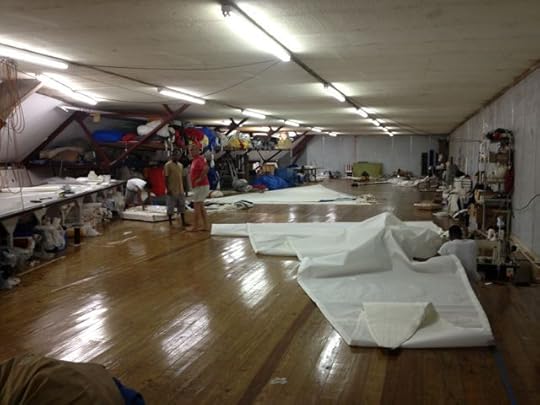 Then yesterday morning when I was standing on the foredeck helping the sailmaker measure how to recut the sail I brought down, I looked over at a dinghy approaching a little wooden boat and I felt like I had entered a time warp. A couple of slender young guys with beards and heads covered with long, shaggy curls stood in a dinghy around a young woman with long hair partly covered with a bandana. They (and their boat) looked the the sailors I used to see in the 1970’s, the young iconoclasts and non-conformists who were cruising on a real shoestring and had neither pensions nor 401K’s. Time has passed and I’m not one of them anymore, but it gives me hope to see they are still out here.
Then yesterday morning when I was standing on the foredeck helping the sailmaker measure how to recut the sail I brought down, I looked over at a dinghy approaching a little wooden boat and I felt like I had entered a time warp. A couple of slender young guys with beards and heads covered with long, shaggy curls stood in a dinghy around a young woman with long hair partly covered with a bandana. They (and their boat) looked the the sailors I used to see in the 1970’s, the young iconoclasts and non-conformists who were cruising on a real shoestring and had neither pensions nor 401K’s. Time has passed and I’m not one of them anymore, but it gives me hope to see they are still out here.
And maybe I’ll get a chance to meet them and hear their story at the barbecue, whenever it is.
Fair winds!
Christine
Share on Facebook




